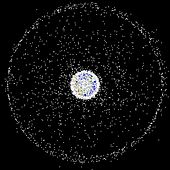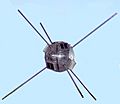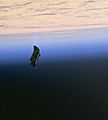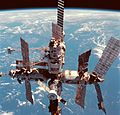Space debris facts for kids

Space debris is the collection of useless objects that are in orbit around Earth, like broken satellites, empty rockets, pieces of metal, and many more. Because of how much space debris there is, collisions happen between space debris and sometimes even operational spacecraft, creating more debris.
Since the start of space programs and the launch of Sputnik 1, NORAD has an active list of all known space launches and objects that are in Earth orbit, including waste parts like booster rockets. This is the Space Object Catalog.
Related pages
Images for kids
-
A computer-generated image representing the locations, but not relative sizes, of space debris as could be seen from high Earth orbit. The two main debris fields are the ring of objects in geosynchronous Earth orbit (GEO) and the cloud of objects in low Earth orbit (LEO).
-
Baker-Nunn cameras were widely used to study space debris.
-
A drifting thermal blanket photographed in 1998 during STS-88.
-
Spent upper stage of a Delta II rocket, photographed by the XSS 10 satellite
-
A micrometeoroid left this crater on the surface of Space Shuttle Challenger's front window on STS-7.
-
Space Shuttle Discovery's lower starboard wing and Thermal Protection System tiles, photographed on STS-114 during an R-Bar Pitch Manoeuvre where astronauts examine the TPS for any damage during ascent
-
Space Shuttle Endeavour had a major impact on its radiator during STS-118. The entry hole is about 5.5 mm (0.22 in), and the exit hole is twice as large.
-
Spatial density of LEO space debris by altitude, according to 2011 a NASA report to the United Nations Office for Outer Space Affairs
See also
 In Spanish: Basura espacial para niños
In Spanish: Basura espacial para niños




















